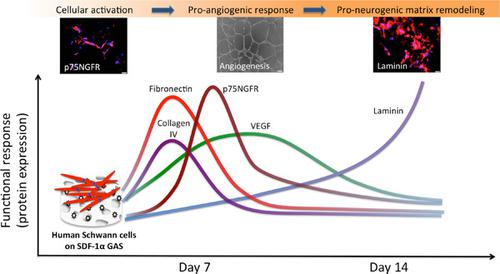当前位置:
X-MOL 学术
›
Biotechnol. Bioeng.
›
论文详情
Our official English website, www.x-mol.net, welcomes your
feedback! (Note: you will need to create a separate account there.)
SDF‐1α gene‐activated collagen scaffold drives functional differentiation of human Schwann cells for wound healing applications
Biotechnology and Bioengineering ( IF 3.5 ) Pub Date : 2020-10-16 , DOI: 10.1002/bit.27601 Ashang L Laiva 1, 2 , Fergal J O'Brien 1, 3, 4, 5 , Michael B Keogh 1, 2
Biotechnology and Bioengineering ( IF 3.5 ) Pub Date : 2020-10-16 , DOI: 10.1002/bit.27601 Ashang L Laiva 1, 2 , Fergal J O'Brien 1, 3, 4, 5 , Michael B Keogh 1, 2
Affiliation

|
Enhancing angiogenesis is the prime target of current biomaterial‐based wound healing strategies. However, these approaches largely overlook the angiogenic role of the cells of the nervous system. Therefore, we explored the role of a collagen‐chondroitin sulfate scaffold functionalized with a proangiogenic gene stromal‐derived factor‐1α (SDF‐1α)—an SDF‐1α gene‐activated scaffold on the functional regulation of human Schwann cells (SCs). A preliminary 2D study was conducted by delivering plasmids encoding for the SDF‐1α gene into a monolayer of SCs using polyethyleneimine‐based nanoparticles. The delivery of the SDF‐1α gene into the SCs enhanced the production of proangiogenic vascular endothelial growth factor (VEGF). Subsequently, we investigated the impact of SDF‐1α gene‐activated scaffold (3D) on the SCs for 2 weeks, using a gene‐free scaffold as control. The transfection of the SCs within the gene‐activated scaffold resulted in transient overexpression of SDF‐1α transcripts and triggered the production of bioactive VEGF that enhanced endothelial angiogenesis. The overexpression of SDF‐1α also caused transient activation of the transcription factor c‐Jun and supported the differentiation of SCs towards a repair phenotype. This was characterized by elevated expression of neurotrophin receptor p75NGFR. During this developmental stage, the SCs also performed an extensive remodelling of the basement matrix (fibronectin, collagen IV, and laminin) to enrich their environment with the pro‐neurogenic matrix protein laminin, revealing an enhanced pro‐neurogenic behavior. Together, this study shows that SDF‐1α gene‐activated scaffold is a highly bioinstructive scaffold capable of enhancing proangiogenic regenerative response in human SCs for improved wound healing.
中文翻译:

SDF-1α 基因激活的胶原支架驱动人雪旺细胞的功能分化,用于伤口愈合应用
增强血管生成是当前基于生物材料的伤口愈合策略的主要目标。然而,这些方法在很大程度上忽略了神经系统细胞的血管生成作用。因此,我们探索了用促血管生成基因基质衍生因子-1α(SDF-1α)-一种SDF-1α基因激活的支架功能化的胶原-硫酸软骨素支架对人雪旺细胞(SCs)的功能调节的作用。通过使用基于聚乙烯亚胺的纳米粒子将编码 SDF-1α 基因的质粒递送到单层 SCs 中,进行了初步的 2D 研究。SDF-1α 基因向 SCs 的传递增强了促血管生成血管内皮生长因子 (VEGF) 的产生。随后,我们研究了 SDF-1α 基因激活支架(3D)对 SCs 的影响 2 周,使用无基因支架作为对照。基因激活支架内 SCs 的转染导致 SDF-1α 转录物的瞬时过表达,并引发生物活性 VEGF 的产生,从而增强内皮血管生成。SDF-1α 的过表达还导致转录因子 c-Jun 的瞬时激活,并支持 SCs 向修复表型分化。这以神经营养因子受体p75NGFR的表达升高为特征。在这个发育阶段,SCs 还对基底基质(纤连蛋白、胶原蛋白 IV 和层粘连蛋白)进行了广泛的重塑,以用前神经元基质蛋白层粘连蛋白丰富它们的环境,揭示了增强的前神经元行为。一起,
更新日期:2020-10-16
中文翻译:

SDF-1α 基因激活的胶原支架驱动人雪旺细胞的功能分化,用于伤口愈合应用
增强血管生成是当前基于生物材料的伤口愈合策略的主要目标。然而,这些方法在很大程度上忽略了神经系统细胞的血管生成作用。因此,我们探索了用促血管生成基因基质衍生因子-1α(SDF-1α)-一种SDF-1α基因激活的支架功能化的胶原-硫酸软骨素支架对人雪旺细胞(SCs)的功能调节的作用。通过使用基于聚乙烯亚胺的纳米粒子将编码 SDF-1α 基因的质粒递送到单层 SCs 中,进行了初步的 2D 研究。SDF-1α 基因向 SCs 的传递增强了促血管生成血管内皮生长因子 (VEGF) 的产生。随后,我们研究了 SDF-1α 基因激活支架(3D)对 SCs 的影响 2 周,使用无基因支架作为对照。基因激活支架内 SCs 的转染导致 SDF-1α 转录物的瞬时过表达,并引发生物活性 VEGF 的产生,从而增强内皮血管生成。SDF-1α 的过表达还导致转录因子 c-Jun 的瞬时激活,并支持 SCs 向修复表型分化。这以神经营养因子受体p75NGFR的表达升高为特征。在这个发育阶段,SCs 还对基底基质(纤连蛋白、胶原蛋白 IV 和层粘连蛋白)进行了广泛的重塑,以用前神经元基质蛋白层粘连蛋白丰富它们的环境,揭示了增强的前神经元行为。一起,











































 京公网安备 11010802027423号
京公网安备 11010802027423号